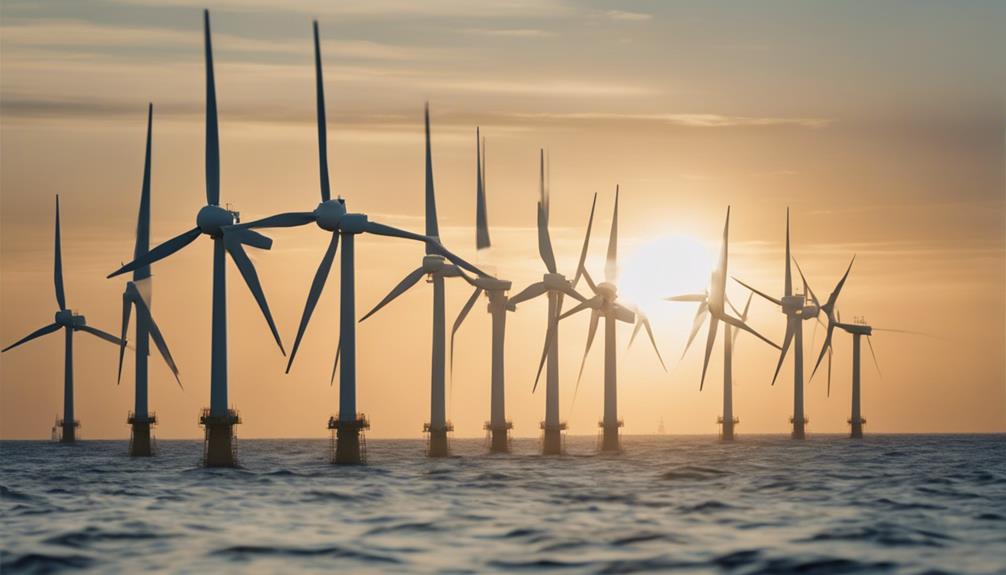BP and Marubeni join forces to drive offshore wind power development in Japan, supporting the nation's renewable energy goals. With BP acquiring a 49% stake in a key offshore wind project off Japan's coast, they aim to contribute to Japan's plan of achieving 10 GW by 2030 and 30-45 GW by 2040 in offshore wind power. The partnership aligns with Japan's commitment to carbon neutrality by 2050, emphasizing sustainability and clean energy sources. This collaboration signifies a significant step towards sustainable energy generation and market expansion in Japan's offshore wind sector.
Key Takeaways
- BP acquires 49% stake in a Japanese offshore wind project.
- Partnership with Marubeni aims to advance Japan's renewable energy goals.
- Environmental impact assessments crucial for project alignment.
- BP establishes a local offshore wind development team in Tokyo.
- Collaboration enhances BP's presence in Japan's growing offshore wind market.
Partnership Overview
The strategic partnership between BP and Marubeni in offshore wind power development in Japan marks a significant step towards achieving the country's ambitious renewable energy targets. By teaming up, the two companies aim to establish a strong presence in Japan's growing offshore wind sector.
BP's acquisition of a 49% stake in an offshore wind project off the coast of Japan solidifies their commitment to expanding low carbon energy sources in the region. This collaboration comes at a pivotal time as Japan sets its sights on developing 10 GW of offshore wind power by 2030 and a staggering 30-45 GW by 2040. The partnership aligns perfectly with Japan's broader goal of reaching carbon neutrality by 2050, emphasizing the importance of clean energy projects like offshore wind farms.
To spearhead their efforts, BP will establish a local offshore wind development team in Tokyo, showcasing their dedication to driving sustainable energy initiatives in the country.
Offshore Wind Project Details
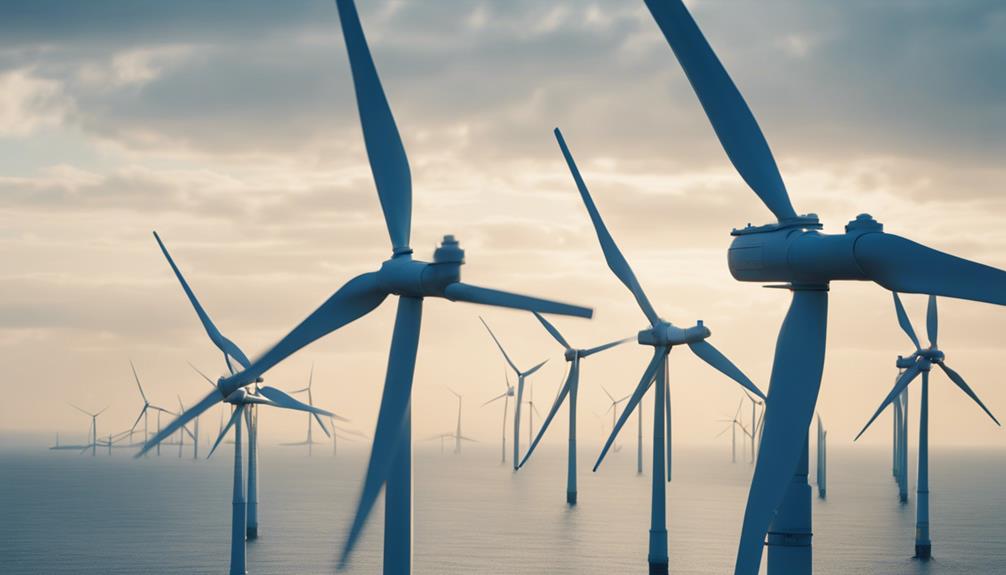
BP and Marubeni's offshore wind project in Japan encompasses a significant scope, with BP securing a 49% stake in the venture.
The project involves key partners collaborating to drive its development forward.
An environmental impact assessment will likely play a vital role in ensuring the project aligns with Japan's ambitious offshore wind targets.
Project Scope Overview
In collaboration with Marubeni, a strategic offshore wind project is underway off the coast of Japan, with BP set to acquire a 49% stake. This renewable energy initiative aligns with Japan's ambitious targets of reaching 10 GW of offshore wind power by 2030 and expanding further to 30-45 GW by 2040.
The project not only contributes to Japan's sustainable energy goals but also supports the nation's overarching objective of achieving carbon neutrality by 2050. BP's commitment to renewable energy development in the region is underscored by the establishment of a local offshore wind development team in Tokyo, tasked with overseeing the project's operations.
Key Partners Involved
Collaborating closely with Marubeni, a strategic offshore wind project is currently unfolding off the coast of Japan. BP and Marubeni have joined forces in a partnership aimed at advancing offshore wind development in Japan.
As part of this collaboration, BP is set to acquire a 49% stake in an offshore wind project alongside Marubeni, marking a significant step towards achieving Japan's ambitious renewable energy targets. With Japan's commitment to reaching carbon neutrality by 2050, the focus on offshore wind energy has intensified, with specific targets of 10 GW by 2030 and 30-45 GW by 2040.
BP's substantial net offshore wind development pipeline, exceeding 5 GW, underlines its dedication to expanding renewable energy projects globally. The partnership between BP and Marubeni underscores a shared goal of establishing a strong presence in Japan's rapidly growing offshore wind market.
This collaboration signifies a pivotal moment in the shift towards sustainable energy sources in Japan, contributing to the country's renewable energy aspirations.
Environmental Impact Assessment
During the evaluation of BP's offshore wind project in Japan, potential effects on marine ecosystems and wildlife are being meticulously assessed. Detailed studies are underway to evaluate the impact of turbine installation on local fish populations and migratory bird routes. These evaluations will also take into account the potential noise pollution from construction activities and operational phases on marine mammals such as whales and dolphins.
Additionally, the assessment will analyze the visual impact of the offshore wind turbines on the surrounding coastal landscapes and scenic views. As part of BP's partnership with Marubeni in Japan, thorough environmental impact assessments are being carried out to guarantee the sustainable development of offshore wind power. By considering these factors, BP aims to minimize any adverse effects on the environment and wildlife while harnessing the potential of offshore wind energy as a clean and renewable power source in Japan.
BP's Role in the Collaboration

BP actively participates in the partnership on offshore wind power in Japan by acquiring a 49% stake in an offshore wind project off the coast, in collaboration with Marubeni. This move underscores BP's strategic commitment to renewable energy initiatives globally.
As an executive vice president expressed, the collaboration aims to establish a local offshore wind development team in Tokyo to spearhead project implementation efficiently. With BP's extensive net offshore wind development pipeline exceeding 5 GW, the company demonstrates a robust dedication to expanding its renewable energy portfolio.
This endeavor aligns with Japan's ambitious targets of achieving 10 GW of offshore wind by 2030 and 30-45 GW by 2040, in line with its carbon neutrality objectives. The partnership between BP and Marubeni marks a significant milestone in establishing a foothold in Japan's burgeoning offshore wind market, paving the way for future growth and sustainable energy practices in the region.
Marubeni's Contribution to the Partnership
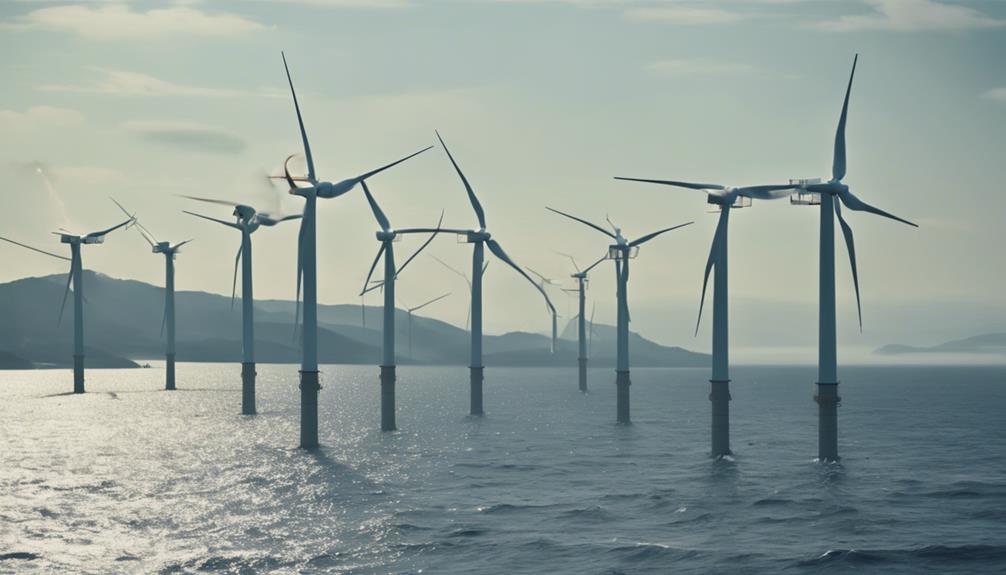
Marubeni, as a prominent offshore wind developer with a substantial 12 GW power generating capacity, brings invaluable expertise to the partnership with BP in Japan. Through its leading role in projects like the 140-MW Akita offshore wind venture, Marubeni showcases its proficiency in the sector.
This collaboration signifies BP's strategic move into Japan's burgeoning offshore wind market, leveraging Marubeni's global track record in wind projects to advance clean energy initiatives in the region.
Marubeni's Expertise in Renewables
With a proven track record in developing significant renewable energy projects, Marubeni brings valuable expertise to the partnership on offshore wind power in Japan.
Marubeni's total power generating capacity of about 12 GW underscores its substantial experience in the energy sector, particularly in renewable energy.
The company's leadership role in the development of the 140-MW Akita offshore wind project exemplifies its prowess in renewable energy projects, showcasing a strong track record in successfully executing offshore wind initiatives.
Marubeni's extensive experience in developing both onshore and offshore wind projects globally cements its position as a key player in the renewable energy market.
As a leading offshore wind developer in Japan, Marubeni's expertise positions it as a critical partner for BP in advancing offshore wind power projects in the region.
The company's proven capabilities and past successes make it a significant asset in driving forward the offshore wind agenda in Japan.
Joint Research and Development
Within this framework, Marubeni plays a crucial role in the collaboration, contributing its expertise to the joint research and development efforts aimed at advancing offshore wind technology in Japan. Leveraging their experience in developing offshore wind projects, Marubeni enhances the partnership's capabilities to drive clean energy initiatives and support Japan's renewable energy goals. Marubeni's specific contributions in this regard include:
- Conducting in-depth research on the latest offshore wind technologies.
- Implementing innovative solutions to enhance the efficiency of offshore wind power generation.
- Collaborating with BP to identify strategic locations for offshore wind projects in Japan.
- Sharing best practices and lessons learned from previous onshore and offshore wind projects.
- Working towards the commercialization of cutting-edge offshore wind technologies to accelerate the growth of clean energy in the region.
Through these collaborative research and development efforts, Marubeni and BP aim to position themselves at the forefront of the offshore wind industry in Japan, driving sustainable energy solutions for the future.
Market Expansion Strategies
In driving market expansion strategies, Marubeni enhances the offshore wind partnership with BP by leveraging its extensive experience in developing large-scale renewable energy projects. With a total power generating capacity of about 12 GW, Marubeni demonstrates a strong capability in the renewable energy sector.
The collaboration with Marubeni allows BP to tap into the company's proven track record in wind development, facilitating the advancement of the offshore wind project in Japan. Marubeni's pivotal role in successfully executing the 140-MW Akita offshore wind project serves as proof of its expertise in the field.
By joining forces with BP, Marubeni strategically positions itself to establish a prominent presence in Japan's burgeoning offshore wind market. This partnership not only benefits both companies but also contributes significantly to the growth and sustainability of renewable energy sources, particularly in the offshore wind sector.
Together, Marubeni and BP are poised to make substantial contributions to Japan's renewable energy landscape, driving innovation and progress in the offshore wind industry.
Impact on Japan's Offshore Wind Market
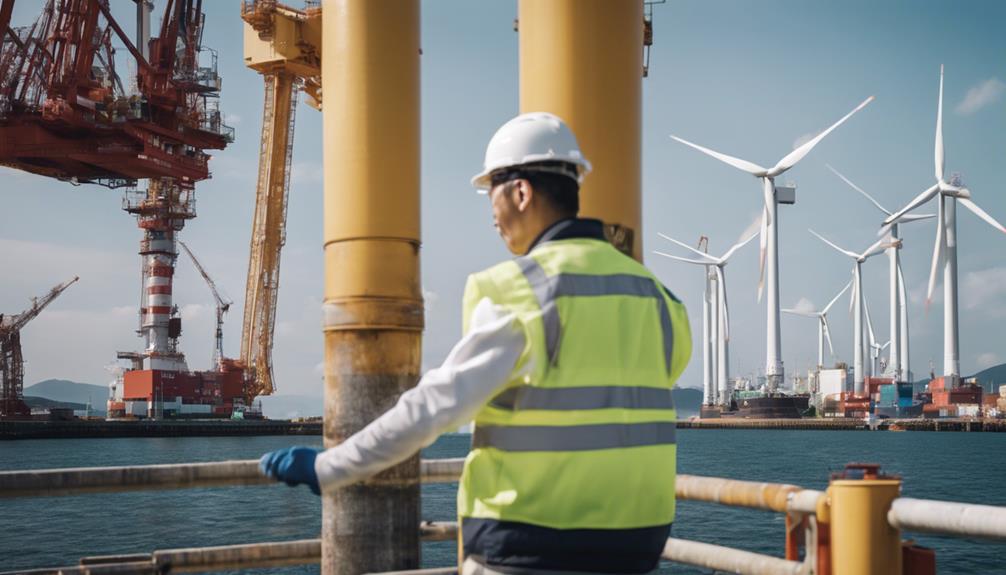
The strategic partnership between BP and Marubeni is positioned to have a significant impact on Japan's offshore wind market by leveraging their combined expertise and resources. This collaboration comes at a pivotal time as Japan sets ambitious targets for offshore wind capacity to support its goal of achieving carbon neutrality by 2050.
- Acceleration of Offshore Wind Development: The alliance between BP and Marubeni is expected to expedite the development of offshore wind projects in Japan.
- Technological Advancements: The partnership may bring about technological advancements in offshore wind energy production in the region.
- Job Creation and Economic Growth: Increased investments in offshore wind could lead to job creation and economic growth in Japan's renewable energy sector.
- Environmental Benefits: The shift towards offshore wind power aligns with Japan's commitment to reducing carbon emissions and promoting sustainable energy sources.
- Global Competitiveness: By expanding their presence in Japan's offshore wind market, BP and Marubeni aim to enhance their global competitiveness in the renewable energy sector.
Future Plans and Sustainability Goals
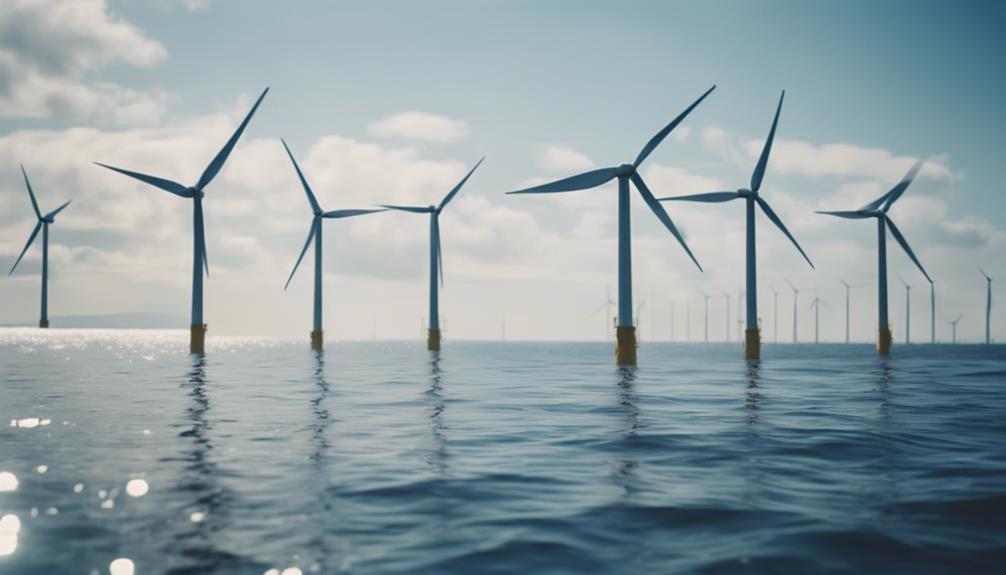
With ambitions to bolster their presence in Japan's offshore wind sector, BP and Marubeni are strategically aligning their efforts to advance sustainability goals. Japan's aggressive targets for offshore wind capacity, including aims of 10 GW by 2030 and 30-45 GW by 2040 as part of its 2050 carbon neutrality objective, provide a solid foundation for this partnership.
BP's plan to establish a local offshore wind development team in Tokyo demonstrates a commitment to driving growth and investment in the Japanese renewable energy market. This partnership not only signifies a significant step towards building a strong presence in Japan's offshore wind sector but also underscores a shared commitment to advancing sustainability goals.
BP's existing offshore wind development pipeline of over 5 GW further emphasizes its dedication to renewable energy projects, aligning perfectly with global efforts towards achieving a greener and more sustainable future. By focusing on offshore wind projects, BP and Marubeni are positioning themselves as key players in Japan's shift towards a cleaner and more sustainable energy landscape.
Frequently Asked Questions
What Is Japan's Offshore Wind Strategy?
Japan's offshore wind strategy aims for 10 GW capacity by 2030, escalating to 30-45 GW by 2040 to support carbon neutrality by 2050. This aligns with the target of 36-38% renewable energy in the power mix by 2030.
The country's commitment and increasing investments in offshore wind projects indicate a flourishing market. Strategic partnerships like BP's collaboration with Marubeni underscore the potential for offshore wind development in Japan's energy landscape.
Does BP Operate in Japan?
BP does operate in Japan, with a recent strategic partnership established for offshore wind projects. This collaboration with Marubeni allows BP to enter the Japanese market and contribute to the country's renewable energy goals.
Leveraging its offshore wind development expertise, BP's presence in Japan signifies its commitment to expanding its renewable energy portfolio. Through this partnership, BP aims to support Japan's ambitious targets for offshore wind capacity and further its renewable energy growth.
What Is the Goal of BP Offshore Wind?
The goal of BP Offshore Wind is to establish a strategic partnership with Marubeni to focus on developing offshore wind power projects in Japan. By acquiring a 49% stake in an offshore wind project off the coast of Japan, BP aligns with Japan's targets of achieving 10 GW of offshore wind power by 2030 and 30-45 GW by 2040.
This partnership reflects BP's commitment to expanding its global offshore wind development pipeline, currently standing at over 5 GW.
What Is Japan's Offshore Wind Target for 2030?
Japan aims to achieve 10 gigawatts (GW) of offshore wind power capacity by 2030. This target aligns with the country's broader goal of reaching 36-38% renewable energy in its power mix by the same year.
The Japanese government has set ambitious plans to expand offshore wind energy, with a target range of 30-45 GW of offshore wind capacity by 2040. These goals are pivotal in Japan's commitment to achieving carbon neutrality by 2050.
Conclusion
To sum up, bp's partnership with Marubeni marks a significant step towards advancing offshore wind power in Japan. This collaboration not only showcases a commitment to sustainable energy solutions but also paves the way for future developments in the country's renewable energy sector.
As the project takes flight, it's clear that these efforts will have a ripple effect, creating waves of change in Japan's offshore wind market. Together, they're harnessing the power of the wind to shape a greener future.
